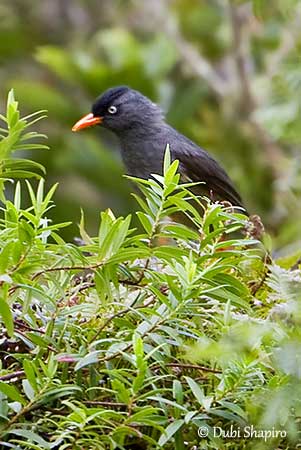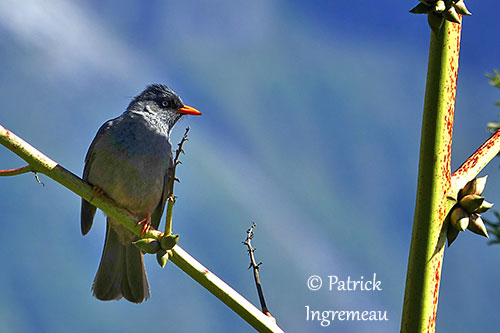
BEHAVIOUR IN THE WILD:
The Reunion Bulbul feeds mainly on fruits, flowers, nectar and insects.
Fruits are taken from both native and introduced plant species, and especially the native Aphloia theiformis, but mistletoes, figs and palm fruits are also part of the diet.
The flowers also include native and exotic species. Insects include small beetles, flies, hemipteran, orthopteran and hymenopteran.
The Reunion Bulbul is a strict forest species and an arboreal fruit-eater, omnivorous bulbul. It is silent while foraging and feeding in middle and upper levels of the forest. It rarely comes to the ground, but it may forage in the low vegetation to reach some fruits.
It feeds alone or in pairs, sometimes in groups of less than ten individuals at abundant food sources. They pluck fruits and flowers directly from the trees, whereas insects are caught by clumsy flycatching and leaping to snatch the prey.
The Reunion Bulbul is probably monogamous. They may become aggressive during the breeding season, but their courtship displays are unknown. The cup-shaped nest is built in tree in the forest.
This species is resident with some altitudinal movements after breeding to reach lower elevations. These movements are probably related to food resources.
The flight is strong and undulating thanks to the wide, rounded wings.
REPRODUCTION OF THIS SPECIES:
The breeding season takes place between July and February, during the dry season and at the beginning of the rains.
The Reunion Bulbul builds a cup-shaped structure in tree or bush in the forest. The nest is made with stems, leaves of ferns, mosses and rootlets. It is often placed in the fork of 3-4 supporting branches.
The female lays 2-3 pale pinkish eggs with dark markings. Recently fledged young can be seen in February/March, but more information is needed.
PROTECTION / THREATS / STATUS:
The Reunion Bulbul is a restricted-range species and it is described as “uncommon”. The numbers were greatly reduced by hunting when the species was classed as gamebird until 1989 and was hunted two months per year. It is now protected by law and the numbers are suspected to be increasing.
Illegal trapping still occur because this bird is appreciated as a songster, and the local cagebird trade is an important threat. It is also affected by slow forest loss within its range, and competition with the introduced Red-whiskered Bulbul.
The population is roughly estimated at 13,700/50,000 mature individuals and is increasing, but the Reunion Bulbul is currently listed as Near Threatened.
Fr: Bulbul de Bourbon
Ang: Reunion Bulbul
All: Reunionbülbül
Esp: Bulbul de Reunión
Ita: Bulbul di Reunion
Nd: Réunionbuulbuul
Sd: réunionbulbyl
Photographers:
Patrick Ingremeau
TAMANDUA
Dubi Shapiro
Dubi Shapiro Photo Galleries & Dubi Shapiro's Pictures on IBC
Text by Nicole Bouglouan
Sources:
HANDBOOK OF THE BIRDS OF THE WORLD Vol 10 by Josep del Hoyo-Andrew Elliott-David Christie - Lynx Edicions - ISBN: 8487334725
The Birds of Africa: Volume VIII: The Malagasy Region: Madagascar, Seychelles, Comoros, Mascarenes - Par Roger Safford, Frank Hawkins – ISBN: 1408190494, 9781408190494- Editeur: A&C Black, 2013
Birds of Madagascar and the Indian Ocean Islands Par Roger Safford, Adrian Skerrett, Frank Hawkins – ISBN: 1472924118, 9781472924117- Editeur: Bloomsbury Publishing, 2015
Hypsipetes borbonicus (Forster, 1781) - Bulbul de La Réunion
Société d’études ornithologiques de La Réunion - Merle Pays, Merle
Wikipedia, the free encyclopaedia
Home page
Page Passeriforme Order
Reunion Bulbul
Hypsipetes borbonicus
Passeriformes Order – Pycnonotidae Family
INTRODUCTION:
The Reunion Bulbul is endemic to Reunion Island where it occurs in forested areas from 300 to 2,500 metres of elevation.
It feeds primarily on fruits from both native and introduced plant species, but it also consumes flowers and nectar, and insects too especially during the nesting period.
It breeds during the austral summer in dry season and at the beginning of the rainy season. The cup-shaped nest is built in tree or bush in forest.
The Reunion Bulbul is threatened by illegal trapping and hunting, and also by habitat loss caused by deforestation. The species is currently listed as Near Threatened.
DESCRIPTION OF THE BIRD:
Biometrics:
Length: 22 cm
Weight: M: 51 g – F: 57 g
The Reunion Bulbul has olive-grey upperparts with browner rump finely streaked black. The tail is dark grey-brown like the upperwing where greater and median coverts are edged olive-grey and lesser coverts are tipped grey.
On the underparts, chin, throat, neck sides and upper breast are dark ashy grey with olive tinge on lower breast, upper belly and flanks, whereas lower flanks are brown. Lower belly and undertail-coverts are olive-buff. On the underwing, coverts and axillaries are pale tawny-brown.

On the head, forehead, crown and central nape are blackish with a shaggy crest formed by elongated, pointed, fine feathers. The lores are blackish. Sides of nape, ear-coverts and cheeks are dark grey with blackish fringes involving scaly pattern.
The bill is orange. The eyes are white. Legs and feet are orange.
Male and female are similar.
The juvenile has paler plumage than adults, with rusty primaries and rectrices. The bill is dark brown.
RANGE:
The Reunion Bulbul is endemic to Reunion Island.
HABITAT:
The Reunion Bulbul occurs in all types of forests including mixed evergreen forest but also degraded forest and native forest with Acacia heterophylla, between 300 and 2,500 metres of elevation. It can be seen below 1,800 metres on slopes of ravines with patches of native forest.
This species avoids cultivated fields, gardens and heath vegetation.
CALLS AND SONGS: SOUNDS BY XENO-CANTO
The Reunion Bulbul’s contact call between mates is a soft chatter. We can also hear a long, drawn-out call, ascending then descending. When the bird is alarmed or aggressive, it gives a “kek” note.
The song is described as melodious and varied. It consists of various chuckling phrases, medium-low wheezing and fluting in short sequences of 2-3 seconds “plew-plew-chi-chu wheer…” or “plee-plew-chirrik-chik…” usually repeated at short intervals. Some variants are produced too.
The bird usually sings from high perch from where it gives its typical “cat-call”.
